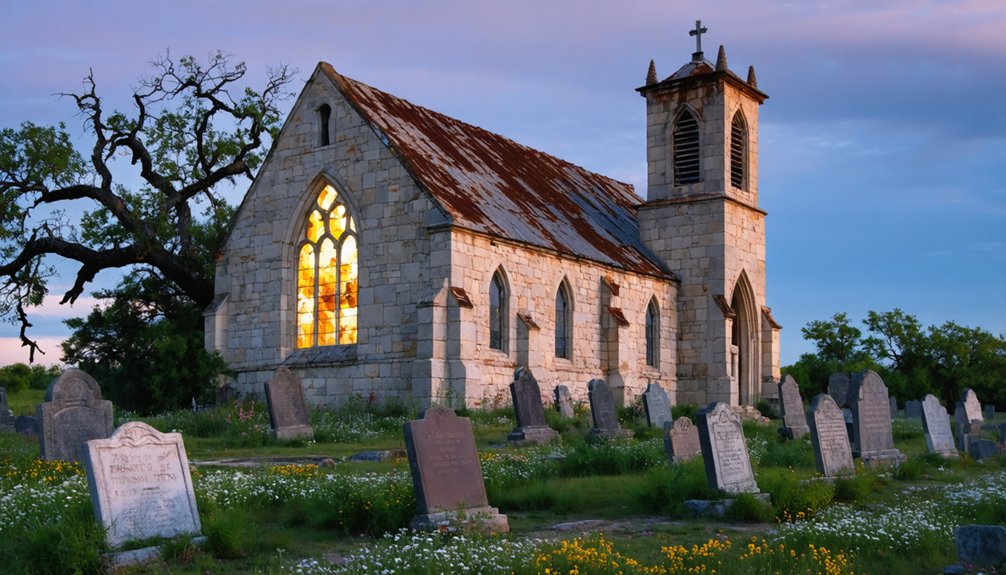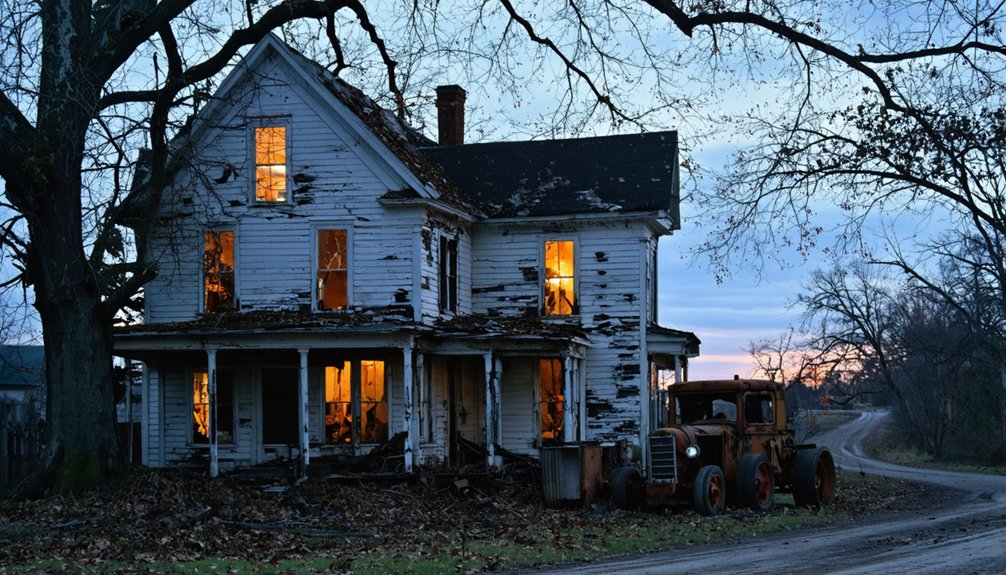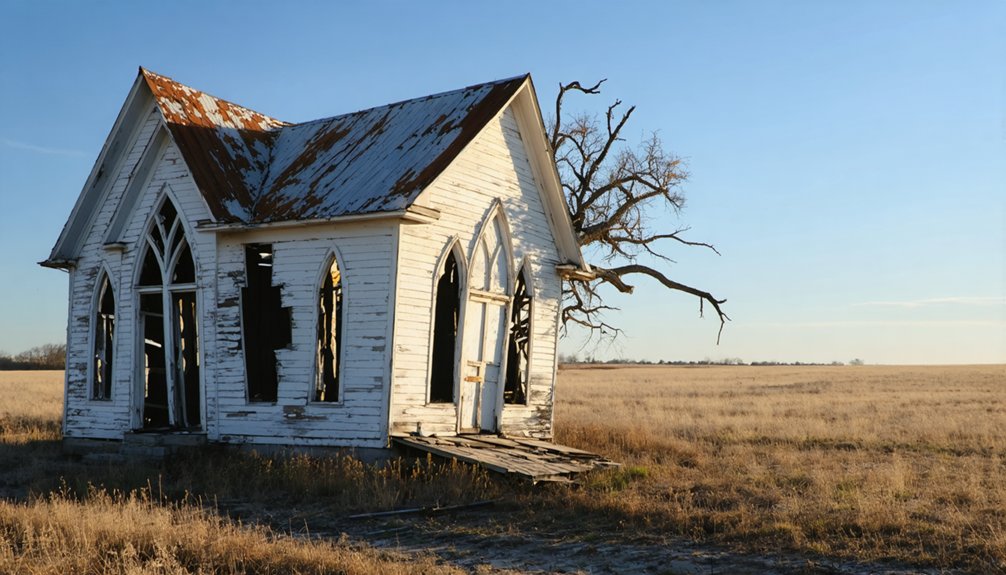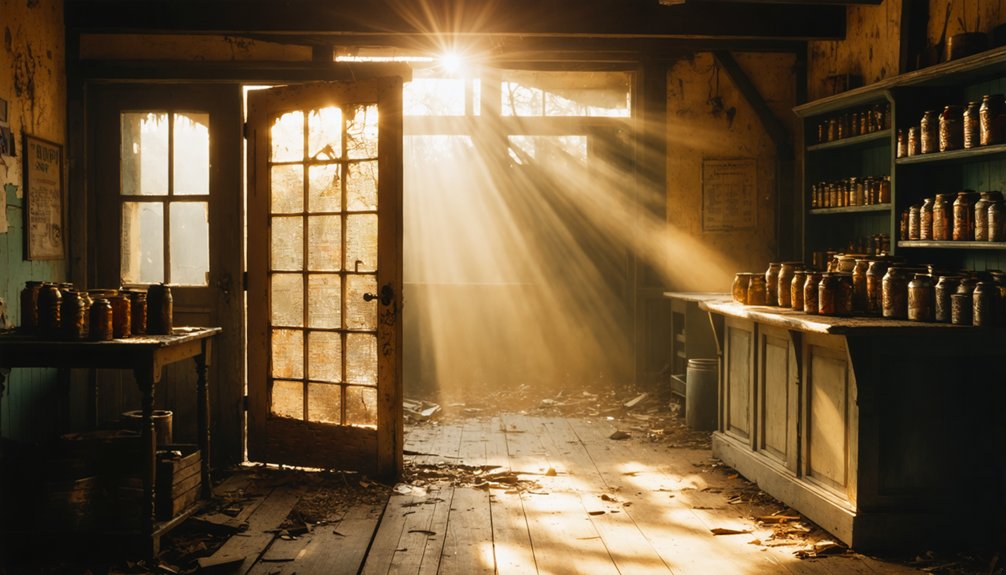You’ll find Fairview’s haunting remains along Old Oakville Road in Texas, where this once-thriving agricultural community flourished from the late 1860s. German and Polish immigrants built a vibrant farming settlement around Henry Hudson’s store and the town’s first post office. Despite early prosperity from cotton farming and ambitious railroad plans, the devastating boll weevil epidemic and economic hardships of the early 20th century transformed Fairview into an abandoned memorial to pioneer life. The crumbling buildings and stone arch bridge hold countless untold stories.
Key Takeaways
- Fairview began as a thriving agricultural community in the 1860s but declined into a ghost town by the mid-20th century.
- The boll weevil epidemic devastated Fairview’s cotton-based economy, forcing many families to abandon their farms and homes.
- Poor infrastructure, including unreliable river crossings and deteriorating roads, contributed to the town’s isolation and eventual abandonment.
- The closure of essential services and lack of economic diversification accelerated Fairview’s transformation into a ghost town.
- Physical remnants include deteriorating buildings and a stone arched bridge over Sloan Creek built around 1890.
Origins and Early Settlement
While many Texas settlements emerged during the post-Civil War reconstruction period, Fairview’s story began with Henry Hudson’s store along Old Oakville Road in the late 1860s.
You’ll find that settlement patterns centered around this essential commercial hub, which housed the community’s first post office established in 1868.
German and Polish immigrants formed the backbone of this western Wilson County community, drawn by the region’s agricultural potential.
European settlers, particularly Germans and Poles, were attracted to Wilson County’s fertile lands, establishing a vibrant farming community in Fairview.
Their pioneering spirit fostered strong community cohesion as they built their lives around farming and local trade. Similar to placer gold miners in other boomtowns of the era, these settlers were drawn by the promise of prosperity in a new land.
The establishment of churches and meeting places strengthened cultural bonds among the settlers, while Hudson’s store served as both a commercial center and social gathering point.
This combination of commerce, agriculture, and shared cultural heritage defined Fairview’s early character in these formative years.
Like its namesake town in West Virginia, Burlington, this Texas settlement would face significant changes as the decades passed.
European Immigration Impact
Although German settlers dominated the early demographics of Fairview, you’ll find that Czech and Polish immigrants also shaped the community’s character through their distinctive cultural contributions.
These European settlers brought their agricultural expertise, introducing diverse farming methods and new crops while maintaining their cultural influence through language, customs, and architectural styles.
You’ll notice how immigrant traditions persisted through the establishment of independent churches, schools, and social organizations.
The settlers’ commitment to cultural autonomy often led to social isolation, particularly among German communities who opposed slavery – a stance that created tension with Anglo neighbors.
Despite these challenges, European immigrants left an indelible mark on Fairview’s development, contributing to its unique blend of American and European heritage through their farming innovations and preserved customs, including traditional Easter fires still celebrated in some Texas German communities.
Most immigrants had agricultural or trade backgrounds, which helped them establish successful farms and businesses in the area.
Railroad Dreams and Economic Setbacks
While you might expect Fairview’s initial railroad development to have secured lasting prosperity, the town’s ambitious rail plans gradually unraveled despite early successes with the Houston and Texas Central Railroad.
The consolidation of Texas railroads in the 1880s by outside interests impacted many local rail operations across the state, including those in Fairview.
The interurban electric train service lasted only until 1948, and recurring flood damage forced costly repairs to the stone bridges and infrastructure throughout the mid-20th century.
The stone arched bridge over Sloan Creek, built around 1890, stands as a testament to the town’s railroad heritage.
The eventual absorption of local rail lines into larger companies, coupled with the abandonment of tracks between Plano and McKinney, marked the end of Fairview’s dreams of becoming a major railway hub.
Failed Railway Plans
In November 1887, Fairview Development Co.’s ambitious railroad plans sparked a land rush when they purchased 3,000 acres between Santa Ana and Newport Bay. Their vision centered on a 100-foot-wide road and motor railway line to the Pacific Ocean, promising robust rail connectivity that would transform the area into a thriving commercial hub. The venture had similar aspirations to Denison’s railway gateway that had successfully connected Texas to northern cities in 1873.
Despite initial success in selling business and residential lots, the railway dreams never materialized as planned. The failed infrastructure became evident as both the Houston & Texas Central Railroad and later interurban lines struggled with maintenance and operational challenges. By June 1888, railroad tracks were completed connecting Santa Ana to Fairview, marking a brief period of progress before the economic downturn.
Economic Dreams Fade Away
Beyond failed railway ambitions, Fairview’s economic challenges stemmed from its limited industrial foundation and isolation from major markets.
While nearby towns like Thurber capitalized on mining operations, Fairview’s community aspirations remained constrained by its small population and lack of diversified industry. You’d find only 175 residents there in 1960, limiting the town’s economic resilience. Just like Thurber’s eventual decline when oil-burning locomotives replaced coal, Fairview struggled to adapt to changing economic conditions.
Transportation barriers intensified these struggles, as you couldn’t easily connect to larger commercial centers before modern highway infrastructure arrived. Today, under the guidance of Economic Development Manager Dave Quinn, the town actively works to expand its commercial tax base and attract new businesses.
Without the Farm Road 1378 and State Highway 5 improvements of the 1960s, Fairview remained economically dormant. Most residents had to commute to neighboring hubs like Plano or McKinney for work, creating a cycle that further reduced local business development.
Even after incorporation in 1958, the town struggled to overcome its economic isolation.
Daily Life in Pioneer Fairview
During the late 1800s and early 1900s, life in pioneer Fairview revolved around agriculture, community gatherings, and local commerce.
You’d find yourself immersed in daily community routines centered around cotton farming, with regular visits to the local blacksmith and cotton gin. Social gatherings at the four churches, Masonic Hall, and public school kept spirits high and neighbors connected.
Cotton farming shaped daily life, while churches, the Masonic Hall, and school wove the social fabric of pioneer Fairview together.
For your basic needs, you’d shop at the local store, communicate through the telephone exchange, and rely on two resident doctors for medical care.
The post office kept you linked to the outside world, while community events strengthened local bonds. Life wasn’t always easy, especially when the boll weevil threatened crops after World War I, but the strong social fabric of Fairview helped sustain its residents through challenging times.
The Old Rock Church Legacy

You’ll find the Old Rock Church‘s pioneering construction showcased through its locally-quarried limestone walls and dirt floors, which were built by settler volunteers in the late 19th century.
The church’s architectural design reflects rural Texas ingenuity, from its simple rectangular layout to wooden plank pews originally supported by keg barrels.
The adjacent cemetery grounds, still preserved today, create a sacred historical complex that connects generations of Fairview residents through both spiritual gatherings and final resting places.
Early Construction History
Founded by Norwegian settlers who arrived in Bosque County in 1854, the Old Rock Church, also known as St. Olaf Kirke, stands as a symbol of pioneering spirit and communal determination.
You’ll find its founding significance in 1886, when Andrew Mickelson and his brothers Christian and Ole led the construction effort after the community purchased the land for $25 in 1884.
The construction techniques showcase remarkable resourcefulness. Local farmers volunteered their labor, quarrying native limestone from nearby hills to build the walls.
You won’t find any modern amenities here – the original church featured dirt floors and simple pews made from planks laid across wooden kegs.
Initially serving as an extension of Our Savior’s Lutheran Church, it formed its own congregation in 1902, reflecting the growing Norwegian community‘s independence.
Architectural Design Elements
The architectural design of St. Olaf’s Church stands as a demonstration of Norwegian immigrant stone craftsmanship, blending Scandinavian Lutheran traditions with Texas frontier resourcefulness.
You’ll find native stone from a nearby mountain forming the church’s exterior walls, originally plastered but now exposed to showcase the authentic masonry work.
Inside, you’ll discover the architectural authenticity preserved through original features like slanted pews, a raised pulpit above the altar, and a historic Vocalion Reed Pump Organ.
The Mickelson brothers’ design deliberately eschews modern amenities, maintaining the building’s 1886 character with a wood-burning stove for heat.
The Swedish bell, installed in 1897, crowns this remarkable structure, while the absence of electricity and plumbing guarantees you’ll experience the church exactly as early Norwegian settlers did.
Cemetery And Sacred Grounds
Since December 1890, when John Page Free became its first burial, Fairview Cemetery has served as hallowed ground between Anson and Tuxedo, Texas.
Originally known as Rock Church Cemetery, this sacred site’s cemetery significance extends beyond its more than 1,000 interments to encompass the region’s military and civic heritage.
The cemetery’s sacred memories live on through:
- Veterans’ graves spanning from the War of 1812 to the Persian Gulf War
- Historic plaques honoring Texas Rangers, congressmen, and governors
- The adjacent Old Rock Church, symbolizing early settlers’ spiritual legacy
- Ground-penetrating radar discoveries of unmarked graves from marginalized groups
You’ll find the cemetery’s distinctive red Texas dirt and minimal grass covering marking this historic ground, now maintained by the Fairview Cemetery Association.
Tales From Baker Mansion

Among Weatherford’s most enigmatic landmarks, Baker Mansion stands as a symbol of both prosperity and tragedy, with construction beginning in 1894 at 304 South Lamar.
You’ll find the 7,000-square-foot Victorian mansion’s history intertwined with the Baker family’s rise and fall. J.D. Baker, a successful dry goods merchant, never saw his dream home completed, dying suddenly on Easter morning in 1899.
The mansion’s dark history includes the death of 13-year-old Ethel Baker and the mysterious case surrounding Charles Baker in 1908.
Today, you’ll hear tales of ghostly encounters, with visitors reporting unexplained voices and electronic phenomena. Paranormal investigators frequently document Audio Voice Phenomenon and Electronic Voice Phenomenon, making Baker Mansion one of Weatherford’s most intriguing haunted locations.
Fairview School and Community Growth
Founded in the late 1800s, Fairview Common School District Number 69 emerged as an essential educational cornerstone after its establishment by the Angelina County School Board.
You’ll discover the school’s significance extended far beyond education, serving as a vibrant hub for community development and civic engagement.
- Classes initially met in a one-room schoolhouse before moving to Fairview Baptist Church from 1905-1913.
- A dedicated two-room schoolhouse was built in 1917 after land purchase in 1915.
- The 1940s brought expansion with a new cafeteria and auditorium.
- Agricultural education programs taught modern farming techniques for cattle, peanuts, corn, and cotton.
The school’s impact lasted until 1963 when it merged with Lufkin School District, though the building continued serving as a community center, preserving its legacy of bringing people together.
Decline and Abandonment

After the Civil War, Fairview’s prosperity hinged precariously on its cotton-based economy, which would ultimately prove to be its undoing.
When the boll weevil epidemic struck, it devastated the area’s cotton crops, triggering a chain reaction that shattered the community’s resilience. You’d have seen families struggling with diminishing agricultural income, forcing them to seek opportunities elsewhere.
The town’s isolation, marked by poor roads and unreliable river crossings, compounded its troubles. Migration patterns shifted as residents moved to better-connected towns, and essential services began shuttering their doors.
Without economic diversification beyond cotton farming, Fairview couldn’t sustain itself. The closures of schools, churches, and businesses accelerated the exodus until only deteriorating buildings remained, marking Fairview’s transformation into a ghost town by mid-20th century.
Historical Sites and Remnants Today
While time has eroded much of Fairview’s original structures, several notable remnants persist as evidence to the town’s prosperous past.
Though weathered by decades, Fairview’s scattered ruins stand as silent witnesses to its former glory and wealth.
You’ll find the foundations of the once-grand Hotel Fairview, known locally as the “big teepee,” alongside scattered ruins from the mining office and general hardware store.
Ghost town exploration reveals these historical treasures:
- Railroad bridges and interurban railway infrastructure along Sloan Creek, including preserved trestle posts
- Bush Springs Dam and a historical cistern that once supplied water to the bustling community
- Building foundations exposed by devastating fires that hastened the town’s abandonment
- Archaeological remnants mapped across two competing town sites
Despite limited historical preservation efforts, you can still trace Fairview’s layout through its remaining foundations, though most structures exist only in historical records and photographs.
Frequently Asked Questions
Are There Any Surviving Photographs of Fairview’s Original Buildings?
You’ll find limited surviving photos through archival research at Texas Escapes magazine, though extensive historical preservation efforts haven’t documented many original buildings. Local historical societies may hold additional unpublished images.
What Natural Disasters or Events Contributed to Fairview’s Abandonment?
While no major tornadoes hit directly, you’ll find recurring droughts devastated local farming in the late 1800s, and flood damage to bridges and roads gradually isolated the community, making trade impossible to sustain.
Did Any Notable Outlaws or Historical Figures Visit Fairview?
You’ll find that outlaw Belle Starr owned 160 acres near Fairview as a hideout, but historical visitors were mainly local figures like landowner Gip Smith and storekeeper R.E. Conine.
What Crops Were Primarily Grown by Fairview’s Farming Community?
You’ll find cotton farming was the main cash crop, while corn production sustained families. They also grew peanuts to enrich the soil, plus vegetables like tomatoes and squash for local use.
When Was the Last Known Permanent Resident in Fairview?
You won’t find a documented date for Fairview’s last resident in community history, as the town’s decline was gradual. Unlike other ghost towns, there’s no definitive record of when the final inhabitant left.
References
- https://fairviewtexas.org/Documents/FAR-10-Nov-2020-Final-1020.pdf
- https://www.hauntedplaces.org/fairview-tx/
- https://en.wikipedia.org/wiki/List_of_ghost_towns_in_Texas
- https://www.texasescapes.com/SouthTexasTowns/Fairview-Texas.htm
- https://www.texasescapes.com/TexasTowns/Tuxedo-Texas.htm
- https://www.backroadstexas.net/nameless-texas/
- https://www.youtube.com/watch?v=VAFXMvICKh4
- https://en.wikipedia.org/wiki/Fairview
- https://www.tshaonline.org/handbook/entries/fairview-tx-tom-green-county
- https://www.tshaonline.org/handbook/entries/fairview-tx-wilson-county



